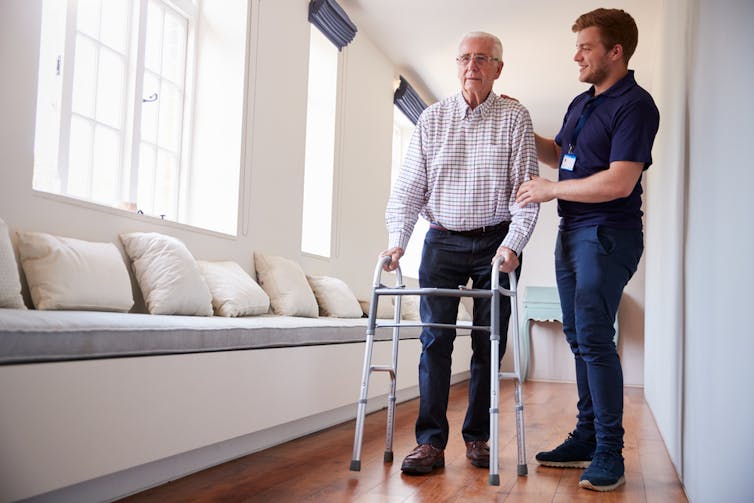Source: The Conversation (Au and NZ) – By Patricia Davidson, Vice-Chancellor, University of Wollongong

Shutterstock
Demand for health care is soaring as the population ages, medical treatments become more widely available and more people live with chronic and complex illnesses.
However, there is global shortage of health professionals – and the pandemic has only accentuated the trend. Overwork, burnout and stress are causing nurses to leave in droves.
The World Health Organization estimates we’ll need a further 9 million nurses worldwide by 2030. According to the International Council of Nurses, the figure is closer to 13 million.
Part of the solution is to recruit and retain more men in nursing. This would help address workforce shortages and could, over time, reduce the industry gender pay gap as the existence of men in nursing becomes more normalised.
And as jobs dry up in traditionally male-focused industries – such as mining and manufacturing – work in health care should be an attractive option for men, providing job security, career opportunities and salary.
But attracting men to the profession won’t be without its challenges. It will require a serious society-wide rethink around gender roles, compensation and recognition for the importance of nursing work.

Shutterstock
Why are there so few men in nursing?
Caregiving is feminised in society and health care, and the nursing profession has strong female foundations. This has established a trajectory and a culture that has kept the representation of men to around 10% in many high income countries.
This is despite fervent efforts by many in the industry to achieve the equity of gender representation you see in most professions.
The reasons are complex and multifaceted. Men in nursing are often portrayed negatively in media and movies. Stereotypes abound.
And some men in nursing face discrimination from patients and staff, underpinned by false assumptions women are better suited to the role. Many people still underestimate the capacity of men to undertake personal care tasks.
Research also shows low male participation can stem from reticence by career counsellors to recommend nursing as a career.
A recent Australian report shows the dominance of women in the nursing workforce may hinder some men from considering nursing as a career, particularly those for whom masculinity is central to their identity. So we must work to undo the perception nursing is a feminine job – it is not.
Negative perceptions around the prestige of nursing and its perceived status in the community may hinder some men’s interest in nursing as a career.
Good role modelling is important. Many educational institutions and supporters such as Johnson & Johnson are working hard to in present positive images of men in nursing and normalise that men can be great nurses too.
Retaining men in the workforce and addressing the ‘glass escalator’
Many regulatory and professional bodies are monitoring the participation of men in nursing. Some organisations offer incentives. For example, The American Association for Men in Nursing offers scholarships, awards and training to attract and retain men in the profession.
It is important to recognise some barriers for men come from within the nursing profession itself.
Some in the nursing workforce perceive that men are on a career “glass escalator”. Unlike a “glass ceiling”, which inhibits career progression, the “glass escalator” allows men to be fast-tracked up the nursing workforce to higher positions in an effort to retain them.
This can cause some to perceive male participation in nursing as a negative, which reduces inclusion.
But this glass escalator phenomenon, which can occur in other industries too, can only be overcome if male participation in the workforce is normalised.
And it is critically important to look at the structural, gender-driven factors that inhibit women embracing leadership roles.
It’s also worth noting women in the health and caregiving sector face a larger gender pay gap than in other economic sectors. A joint report by the International Labour Organization and the World Health Organization found:
Women in the health and care sector face a larger gender pay gap than in other economic sectors, earning on average of 24% less than peers who are men […] Within countries, gender pay gaps tend to be wider in higher pay categories, where men are over-represented. Women are over-represented in the lower pay categories.
Although this differential is not easily explained, it does reflect the value society ascribes to caregiving. If women are over-represented in the lower pay categories (which tend to focus more on personal care tasks) that suggests society ascribes low value to caregiving tasks, and over-representation of women in caregiving helps to further “feminise” caregiving.
It is highly likely these factors conspire to dissuade men and boys from getting started in nursing and undertaking caregiving roles within the profession.

Shutterstock
Time for action
We urgently need more men in nursing.
Not only does this make good sense for health care, as it presents opportunities for engagement with men, but also good sense for our society and economic productivity. Investment in education and job creation in the health and social sectors could improve health outcomes, shore up global health security, and boost inclusive economic growth.
Perhaps most importantly, robust health care systems should be representative of the populations they serve. The workforce in any industry should be drawn from a range of perspectives, including gender and culture.
Read more:
Friday essay: saints or monsters, pop culture’s limited view of nurses
![]()
Patricia Davidson is Vice Chancellor and President of the University of Wollongong and is Dean Emerita at the Johns Hopkins School of Nursing. She has previously received funding from the National Health & Medical Research Council, Australian Research Council, National Heart Foundation, NSW Cancer Institute and National Institutes for Health in the United States.
Caleb Ferguson works for the School of Nursing, University of Wollongong, NSW, Australia. He receives funding from the National Health & Medical Research Council, and has received funding from the Stroke Foundation and Heart Foundation.
Jason Farley works for Johns Hopkins University School of Nursing. He receives funding from the National Institutes of Health, Baltimore City Health Department, and the Centers for Disease Control and Prevention.
– ref. Getting more men into nursing means a rethink of gender roles, pay and recognition. But we need them urgently – https://theconversation.com/getting-more-men-into-nursing-means-a-rethink-of-gender-roles-pay-and-recognition-but-we-need-them-urgently-184829







